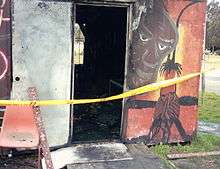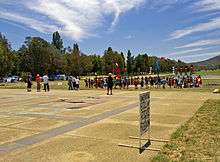Aboriginal Tent Embassy
The Aboriginal Tent Embassy is a permanent protest occupation site as a focus for representing the political rights of Aboriginal Australians. First established in 1972 as a protest against the McMahon government’s approach to Indigenous Australian land rights, it is made up of signs and tents. Since 1992 it has been located on the lawn opposite Old Parliament House in Canberra, the Australian capital. It is not considered an official embassy by the Australian Government. The targets of protests at the Embassy have changed over time, and as of 2020 include not only land rights but also Indigenous sovereignty and self-determination.
History
On 26 January 1972, four Aboriginal men (Michael Anderson, Billy Craigie, Tony Coorey and Bertie Williams) arrived in Canberra from Sydney to establish the Aboriginal Embassy by planting a beach umbrella on the lawn in front of Parliament House (now Old Parliament House).[1] The Embassy was established in response to the McMahon Coalition Government's refusal to recognise Aboriginal land rights or native title in Australia. McMahon instead favoured a new general-purpose lease for Aboriginal people which would be conditional upon their "intention and ability to make reasonable economic and social use of land", while reserving for the Crown rights to minerals and forestry.[2]
The beach umbrella was soon replaced by several tents and Aboriginal people and non-Indigenous supporters came from all parts of Australia to join the protest. The occupiers were told by Kep Enderby that they were legally entitled to camp outside Parliament since it was Commonwealth Land. Chicka Dixon stated "I became the 'Minister for Defence' and we gave ourselves portfolios. We painted the gutter No Parking Aboriginal Staff Only and then we introduced the (Aboriginal) flag."[3]
During the first six months of its life in 1972 the Embassy succeeded in uniting Aboriginal people throughout Australia in demanding uniform national land rights and mobilised widespread non-Indigenous support for the cause. Other people associated with the Embassy demonstration in 1972 include Paul Coe, Gary Foley, Gary Williams, John Newfong, Sam Watson, Pearl Gibbs, Roberta Sykes, Alana Doolan, Cheryl Buchannan, Pat Eatock, Kevin Gilbert, Denis Walker, Isobelle Coe and Shirley Smith.[4]
In February 1972 the Aboriginal Tent Embassy presented a list of demands to Parliament:[5]
- Control of the Northern Territory as a State within the Commonwealth of Australia; the parliament in the Northern Territory to be predominantly Aboriginal with native title and mining rights to all land within the Territory.
- Legal title and mining rights to all other presently existing Aboriginal reserve lands and settlements throughout Australia.
- The preservation of all sacred sites throughout Australia.
- Legal title and mining rights to areas in and around all Australian capital cities.
- Compensation money for lands not returnable to take the form of a down-payment of A$6 billion and an annual percentage of the gross national income.
The demands were rejected, and following an amendment to the Trespass on Commonwealth Lands Ordinance (which made the occupation a squat which could then be evicted), police moved in without notice in July 1972.[3] They removed the tents and arrested eight people.[6] Three days later, 200 activists returned to the site and were prevented from reoccupying it by 200 police. A week later, 1000 people came back to resquat the site again. Chicka Dixon commented "we decided to fight the coppers, so we armed ourselves with little sticks". The police did not intervene, and after listening to speeches the crowd dispersed peacefully.[3]
The ACT Supreme Court ruled in September 1972 that the amendment to the Trespass on Commonwealth Lands Ordinance did not allow for the eviction of the Embassy, and it was re-erected. A Bill was quickly added to make the Ordinance retrospective, and the Embassy was evicted again the next day.[7]
In October 1973, around 70 Aboriginal protesters staged a sit-in on the steps of Parliament House and the Tent Embassy was re-established. The sit-in ended when Labor Prime Minister Gough Whitlam agreed to meet with protesters.[5]
In May 1974 the embassy was destroyed in a storm, but it was re-established in October.
In February 1975 Aboriginal activist Charles Perkins negotiated the "temporary" removal of the Embassy with the Government, pending Government action on land rights. The Fraser Government subsequently enacted the Aboriginal Land Rights Act 1976, after its drafting by the Whitlam Labor Government in 1975.
In March 1976, the Embassy was established in a house in the nearby suburb of Red Hill; however, this closed in 1977.
For a short period in 1979, the embassy was re-established as the "National Aboriginal Government" on Capital Hill, site of the proposed new Parliament House.
On the twentieth anniversary of its founding, the Aboriginal Tent Embassy was re-established at the original site on the lawns of Old Parliament House in 1992. Despite being a continual source of controversy, with many calls for its removal, it has existed on the site since that time.[6]
The site of the Tent Embassy was added to the Australian Register of the National Estate in 1995, as the only Aboriginal site in Australia that is recognised nationally as representing political struggle for all Aboriginal and Torres Strait Islander people.[7] Some elders of the local Ngunnawal people called for the eviction of the Tent Embassy in 2005, viewing it as an eyesore.[8]
In the leadup to the 2000 Sydney Olympics, Isobell Coe from the Wiradjuri Nation set up a Peace Camp and combined ashes from Canberra's sacred fire to the fire at Victoria Park in Camperdown, New South Wales to promote reconciliation.[9] This sacred fire was originally made by Kevin Buzzacott and lit by Wiradjuri man Paul Coe at the embassy in 1998.[10]
There have also been a number of suspicious fires at the site.[6] The most devastating fire took place in June 2003, when 31 years of records were lost.[11]
2005 consultation

In August 2005, the Federal Government announced a review into the Aboriginal Tent Embassy. They consulted with Aboriginal communities around Australia to determine what shape the Tent Embassy should take in the future.[12] The group was headed by Minister Jim Lloyd and included a number of Aboriginal elders from around Australia. Professional mediators Callum Campbell and Tom Stodulka were called in to facilitate the process and consult with Indigenous and non-Indigenous Australians, to obtain and represent their views. They reached a decision on the Embassy's future early in December 2005.
Fortieth anniversary

On Australia Day, 26 January 2012, the Embassy was celebrating its fortieth anniversary. The National Congress of Australia's First Peoples had planned a series of events over two days, to celebrate the struggle for Aboriginal land rights and the theatre of political protest.[3]
What became known as the Australia Day 2012 protests occurred when Prime Minister Julia Gillard and Opposition Leader Tony Abbott went to the Lobby Restaurant, close to the embassy site. That morning Abbott had been asked whether he found the Embassy "still relevant" and he had replied "I think the Indigenous people of Australia can be very proud of the respect in which they are held by every Australian and, yes, I think a lot has changed since then and I think it probably is time to move on from that".[13]
These comments angered activists since they felt Abbott was proposing that the Embassy should be evicted. Gillard and Abbott were hastily escorted from the restaurant under the protection of police officers, and during the scramble Gillard lost one of her shoes, which was collected by protesters. At first the Embassy posted on its Facebook page that the shoe would be returned only in exchange for stolen land, but the shoe was later returned to her.[14][15][16][17][18]
Other Aboriginal tent embassies
In 2012, there were six other tent embassies dotted around the nation.[19]
References
- Dow, Coral (4 April 2000). "Aboriginal Tent Embassy: Icon or Eyesore?". Parliament of Australia. Canberra: Parliamentary Library. Archived from the original on 17 October 2013. Retrieved 31 May 2010.
- McMahon, William. "AUSTRALIAN ABORIGINES COMMONWEALTH POLICY AND ACHIEVEMENTS STATEMENT BY THE PRIME MINISTER — The Rt Hon. William McMahon, C.H., M.P. (pdf)" (PDF). Collaborating for Indigenous Rights. National Museum Australia. Retrieved 29 May 2019.
- McLaren, Nick (20 January 2012). "40 years of canvas diplomacy". ABC news. Retrieved 29 May 2019.
- Australia Day under a beach umbrella, Collaborating for Indigenous Rights, National Museum of Australia Archived 17 March 2012 at the Wayback Machine
- "The Bush Capital « The Global Dispatches". www.theglobaldispatches.com. Retrieved 13 April 2018.
- "Timeline: Aboriginal Tent Embassy". SBS. 3 September 2013. Retrieved 29 May 2019.
- "Aboriginal Embassy Site, King George Tce, Parkes, ACT, Australia (Place ID 18843)". Australian Heritage Database. Department of the Environment. Retrieved 31 May 2010.
- "The Future of the Tent Embassy". Message Stick. Australian Broadcasting Corporation. 25 November 2005. Archived from the original on 27 April 2016. Retrieved 31 May 2010.
- Fire of the Land (2002 documentary)
- "Five Fast Facts: The Aboriginal Tent Embassy". Archived from the original on 13 May 2013. Retrieved 20 February 2014.
- Yaxley, Louise (19 June 2003). "Aboriginal Tent Embassy burnt out". The World Today. Australian Broadcasting Corporation. Retrieved 31 May 2010.
- Truscott, Marilyn. "Reconciling two settings: responding to threats to social and scenic heritage values" (PDF). International Council on Monuments and Sites. Retrieved 31 May 2010.
- Jessica Wright; Dan Harrison; Dylan Welch (27 January 2012). "Australia Day Turns Ugly". The Sydney Morning Herald. Retrieved 29 May 2019.
- "Aboriginal protesters overreacted to Tony Abbott, says Warren Mundine". Australian Associated Press. 29 May 2019.
- "Riot police rescue Gillard, Abbott from protesters". abc.net.au. 26 January 2012. Retrieved 13 April 2018.
- Packham, Ben; Vasek, Lanai (27 January 2012). "Gillard, Abbott escorted under guard amid Aboriginal Tent Embassy protest". The Australian.
- http://www.heraldsun.com.au/news/more-news/police-called-after-gillard-and-abbott-trapped-by-protesters-in-canberra/story-fn7x8me2-1226254409434
- Medhora, Shalailah (27 January 2012). "Gillard's shoe returned after protest". SBS. Retrieved 7 April 2014.
- "'Intercontinental Cry' Article on Australian Sovereignty movement". Sovereign Union:First Nations Asserting Sovereignty. 1 January 2010. Retrieved 20 July 2020.
Further reading
- "Aboriginal Tent Embassy". National Museum of Australia. Defining Moments. 13 April 2018.
- Cowan, Greg. "Nomadic Resistance: Tent Embassies and Collapsible Architecture". Archived from the original on 24 July 2010.
- Cowan, Gregory (2001). "Collapsing Australian Architecture: the Aboriginal Tent Embassy" (PDF). Journal of Australian Studies (67): 30–36. Archived from the original (PDF) on 30 September 2012.
- Foley, Gary (5 October 2001). "Black Power in Redfern: 1968–1972". Archived from the original on 30 April 2019.
- Lothian, Kathy (December 2007). "Moving Blackwards: Black Power and the Aboriginal Embassy". In Hannah, Mark; Macfarlane, Ingereth (eds.). Transgressions: Critical Australian Indigenous histories. ANU Press. Aboriginal History Monographs 16. doi:10.22459/T.12.2007. ISBN 9781921313431.
- Midena, Kate; Bourchier, Dan (28 June 2020). "Aboriginal Tent Embassy in Canberra still 'the ground zero for First Nations people' nearly 50 years on". ABC News. Australian Broadcasting Corporation. Retrieved 29 June 2020.
- Robinson, Scott (1994). "The Aboriginal Embassy: An Account of the Protests of 1972" (PDF). Aboriginal History. 18 (1): 49–63.
- "Timeline: Aboriginal Tent Embassy". SBS News. 1 January 1970.
External links
| Wikimedia Commons has media related to Aboriginal Tent Embassy. |
- Three short clips from the film Ningla-A-Na (Hungry for our Land) (1972), National Film and Sound Archive – includes footage of police marching on protesters in June 1972.
- The embassy on Koori History
- Robert Campbell Jr, Aboriginal Embassy (1986) (painting)
- Speeches recorded at the Embassy, 30 July 1972 (part 1)
- Speeches recorded at the Embassy, 30 July 1972 (part 2)
- Statement of Significance for Aboriginal Embassy in Australian Heritage Database
- Interactive panorama of the Tent Embassy in 2006 by Norman Peters.
- Video of Uncle Kevin Buzzacott reclaiming Emu and Kangaroo from the Australian Coat of Arms on 30th Anniversary of the Tent Embassy in 2002.